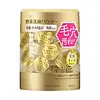What's inside
What's inside
 Key Ingredients
Key Ingredients

 Benefits
Benefits

 Concerns
Concerns

 Ingredients Side-by-side
Ingredients Side-by-side

Zea Mays Starch
AbsorbentSodium Cocoyl Isethionate
CleansingSodium Lauroyl Glutamate
Diglycerin
HumectantAllantoin
Skin ConditioningMaltodextrin
AbsorbentPapain
Skin ConditioningCI 77004
Cosmetic ColorantSodium Bicarbonate
AbrasiveCitric Acid
BufferingSodium Polyacrylate
AbsorbentWater
Skin ConditioningOryza Sativa Powder
Oryza Sativa Lees Extract
Skin ConditioningOryza Sativa Bran Water
Masking1,2-Hexanediol
Skin ConditioningOryza Sativa Extract
AbsorbentButylene Glycol
HumectantDipropylene Glycol
HumectantHydrolyzed Rice Protein
Skin ConditioningOryza Sativa Seed Protein
AntioxidantCeramide NP
Skin ConditioningAscorbic Acid
AntioxidantAlpha-Arbutin
AntioxidantProtease
ExfoliatingCaprylyl Glycol
EmollientGlucose
HumectantGlycerin
HumectantTartaric Acid
BufferingLactic Acid
BufferingZea Mays Starch, Sodium Cocoyl Isethionate, Sodium Lauroyl Glutamate, Diglycerin, Allantoin, Maltodextrin, Papain, CI 77004, Sodium Bicarbonate, Citric Acid, Sodium Polyacrylate, Water, Oryza Sativa Powder, Oryza Sativa Lees Extract, Oryza Sativa Bran Water, 1,2-Hexanediol, Oryza Sativa Extract, Butylene Glycol, Dipropylene Glycol, Hydrolyzed Rice Protein, Oryza Sativa Seed Protein, Ceramide NP, Ascorbic Acid, Alpha-Arbutin, Protease, Caprylyl Glycol, Glucose, Glycerin, Tartaric Acid, Lactic Acid
Talc
AbrasiveMaltitol
HumectantSodium Cocoyl Isethionate
CleansingSodium Myristoyl Glutamate
CleansingSodium Lauroyl Glutamate
Sodium C14-16 Olefin Sulfonate
CleansingPotassium Laurate
EmulsifyingCarrageenan
Glycyrrhiza Glabra Root Extract
BleachingSqualane
EmollientCitric Acid
BufferingSodium Hyaluronate
HumectantHelianthus Annuus Seed Oil
EmollientPersea Gratissima Oil
Skin ConditioningBHT
AntioxidantDipropylene Glycol
HumectantSilk
Ethyl Glucoside
HumectantProtease
ExfoliatingLipase
Skin ConditioningSodium Benzoate
MaskingTalc, Maltitol, Sodium Cocoyl Isethionate, Sodium Myristoyl Glutamate, Sodium Lauroyl Glutamate, Sodium C14-16 Olefin Sulfonate, Potassium Laurate, Carrageenan, Glycyrrhiza Glabra Root Extract, Squalane, Citric Acid, Sodium Hyaluronate, Helianthus Annuus Seed Oil, Persea Gratissima Oil, BHT, Dipropylene Glycol, Silk, Ethyl Glucoside, Protease, Lipase, Sodium Benzoate
 Reviews
Reviews

Ingredients Explained
These ingredients are found in both products.
Ingredients higher up in an ingredient list are typically present in a larger amount.
Citric Acid is an alpha hydroxy acid (AHA) naturally found in citrus fruits like oranges, lemons, and limes.
Like other AHAs, citric acid can exfoliate skin by breaking down the bonds that hold dead skin cells together. This helps reveal smoother and brighter skin underneath.
However, this exfoliating effect only happens at high concentrations (20%) which can be hard to find in cosmetic products.
Due to this, citric acid is usually included in small amounts as a pH adjuster. This helps keep products slightly more acidic and compatible with skin's natural pH.
In skincare formulas, citric acid can:
While it can provide some skin benefits, research shows lactic acid and glycolic acid are generally more effective and less irritating exfoliants.
Most citric acid used in skincare today is made by fermenting sugars (usually from molasses). This synthetic version is identical to the natural citrus form but easier to stabilize and use in formulations.
Read more about some other popular AHA's here:
Learn more about Citric AcidDipropylene Glycol is a synthetically created humectant, stabilizer, and solvent.
This ingredient helps:
Dipropylene glycol is technically an alcohol, but it belongs to the glycol family (often considered part of the ‘good’ alcohols). This means it is hydrating and gentle on skin unlike drying solvent alcohols like denatured alcohol.
As a masking agent, Dipropylene Glycol can be used to cover the smell of other ingredients. However, it does not have a scent.
Studies show Dipropylene Glycol is considered safe to use in skincare.
Learn more about Dipropylene GlycolThese enzymes break down protein into smaller peptides and amino acids. They also encourage the formation of new protein.
Our skin uses peptides, amino acids, and protein for maintaining healthy skin cells.
Protease work by breaking peptide bonds in protein with hydrolysis. This is the process of breaking bonds using water.
An in-vitro study (not done on a living organism) found a blend of 3-protease decreases skin inflammation by mitigating the effects of other proteins.
One manufacturer that uses subtilisin, a protease from Bacillus subtilis, claims this ingredient is exfoliating, promotes cell regeneration, and is a good substitute for AHAs. Further research is needed to back up these claims.
Fun fact: The human body contains ~641 protease genes.
Learn more about ProteaseSodium cocoyl isethionate is a natural ingredient from coconut oil. It is an ultra gentle cleanser that gives a nice foam without drying the skin or impacting the skin barrier.
The amount of foam created depends on the amount of sodium cocoyl isethionate used in the product.
This ingredient also helps improve the spreadability of a product.
Learn more about Sodium Cocoyl IsethionateSodium Lauroyl Glutamate is the sodium salt from the lauric acid of glutamic acid.
It is a surfactant and helps cleanse the skin. Surfactants gather oil, dirt, and other pollutants from your skin so they may be washed away easily.